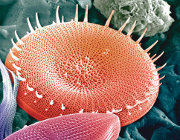Home :: List of Publicly Available Datasets :: Proboscia alata PI-D3
Proboscia alata PI-D3
Downloads:
| Principle Investigator(s) | Bank Beszteri |
|---|---|
| External sample ID | P. alata CTR 1 |
| NCGR Sample ID | MMETSP0174 |
| Sample accession number | CAM_SMPL_002451 |
| Assembly accession number | CAM_ASM_000269 |
| Combined Assembly Name | Proboscia-alata-PI_D3 |
| Genus | Proboscia |
| Species | alata |
| Strain | PI-D3 |
| Clonal | Yes |
| Axenic | No |
| Prelim. NCBI Taxon ID | 216777 |
| 18S rRNA | |
| Importance of organism and transcriptomes | P. alata is a cosmopolitan species that can occasionally form large blooms. This transcriptome is part of a comparative study of the transcriptomic responses of Southern Ocean diatoms to iron limitation. |
| Additional citations and references | |
| Environmental Data | |
| Primary citation for organism's characterization, if available | (Brightwell) Sundstrom 1986: 99, figs 258-266 |
| Latitude | -64.0038 |
| Longitude | -.0025 |
| Collection date | 20-JAN-08 |
| Sample collection site | Southern_Ocean |
| Other collection site info | expedition ANT-XXIV / 2 |
| Sample material (e.g. "seawater," "sediment," etc.) | seawater |
| ENVO term for habitat - primary term | Acquatic: marine |
| Other environmental metadata available | further metadata available at http://www.pangaea.de |
| Other environmental metadata available | further metadata available at http://www.pangaea.de |
| Habitat | marine habitat |
| Experimental Data | |
| Date of experiment | 26-MAY-11 |
| Growth medium | modified f/2 amended seawater |
| Modifications to growth medium | Using trace metal solution after Morel et al. 1979. medium set up using trace metal clean conditions and procedures. |
| Temperature (ºC) | 3 |
| Salinty (psu) | 33.6 |
| pH | 8.15 |
| Light (µmol photons / m2 / sec) | 35 |
| Day portion of day:night cycle in hours | 16 |
| Night portion of day:night cycle in hours | 8 |
| Nitrate (μmol/L) | 28 |
| Ammonium (μmol/L) | .09 |
| Phosphate (μmol/L) | 28.45 |
| Silicate (μmol/L) | 60 |
| Total Fe (nmol/L) | 11000 |
| Trace elements (total) (nmol/L) | 7.3 |
| Investigation type | Eukaryotes |








